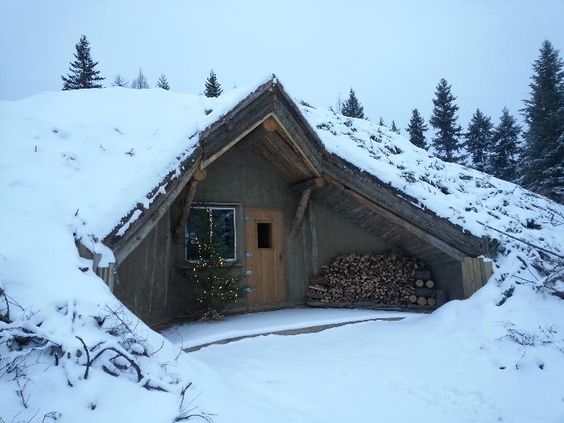At one time or another, we have all lamented over the cost of an average home. It does not have to be crazily big. Just something comfortable, where we can live and possibly enjoy nature and ponder over everything God has given to us. Here it is:
Let us suppose that the cost to build a conventional home is $100,000. To build the same home, but as a straw bale home, it would cost about $130,000. For cob, provided that you paid for the labor (as you did with the conventional home) about $170,000. And an earthship would ring in at about $180,000.
This always struck me as a bit frustrating. I wish there was a way to build a natural home that would cost less than building a conventional home. It seems that if you use materials from the land where the home is being built, you should be able to dramatically cut building costs.
I started merging a lot of ideas together and came up with something I later called “wofati.”Imagine living in something that looks like a log cabin from the inside, but with more light. It doesn’t need heat in the winter or A/C in the summer. And the cost, including labor, works out to about half.
The basic wofati design principles are:
Every drop of rain must always have a complete downhill soil path. Encountering the edge of the roof is not okay.
There are two layers of polyethylene. The lower layer, which hugs the structure, and the upper layer, which defines the thermal mass that surrounds the structure. The upper layer must cover at least twice as much square feet as the available square feet in the structure.
The uphill side has at least three open trenches to move water around the structure.
The uphill side has a roof that extends at least three feet beyond the exterior wall.
There is at least four inches of dirt between the two layers of polyethylene. There is at least sixteen inches of dirt on the top layer of polyethylene.
The inner pole structure is made of logs.
No treated wood is used in any of the structure.
All polyethylene is surrounded on both sides by at least 10 sheets of newspaper. If the wood shell is unmilled logs or poles, much more newspaper must be used.
And there is your home. No, it may not be glamorous but it is functional and, when you think about it, you can pretty much design the inside any way you like it! And again, it is inexpensive!
In our book, if you have a home, it is paid off, and it is practical as it is comfortable then you and your family have it made!
To read more on this wofati go to Practical Permaculture.
Featured Image via Permies

https://youtu.be/J98WVONijEg
Thermal mass is a cool idea, water infiltration is a forever problem.
Eventually this will leak, no way around that, water will seek the path of least resistance under hydrostatic pressure.
The best possible structure in terms of cost and ease of construction is standard framing using super insulated principles.
Also, keep in mind carbon monoxide poisoning and fire egress.
This is a serious problem that isn’t considered enough imo.
Carbon monoxide, produced by a fire place burning oxygen and simply breathing, can kill every person in an airtight home within hours.
We’ve all seen news reports of entire families dying of carbon monoxide.
Also, keep in mind carbon monoxide poisoning and fire egress.
This is a serious problem that isn’t considered enough imo.
Carbon monoxide, produced by a fire place burning oxygen and simply breathing, can kill every person in an airtight home within hours.
We’ve all seen news reports of entire families dying of carbon monoxide.
This looks so cool Cliff Ray
I love this
Caitlin Lyke
It would be nice to see the inside
ok so what was the actual cost and why no pics of the inside?
I was already subscribed to this guy from his work at Standing Rock.
Cool!
Herk Haston
This is the best! way to go…
On the walk out’s if you had a three seeasin’s room would build on would give you heat,and you could grow veg.s too
Where am I supposed to poop?
Like a soddie! Cool beans
Keaun Kennedy